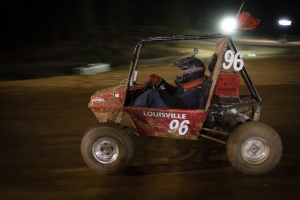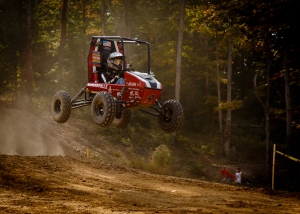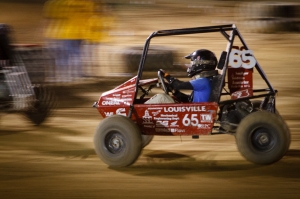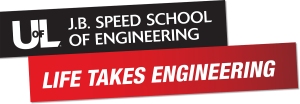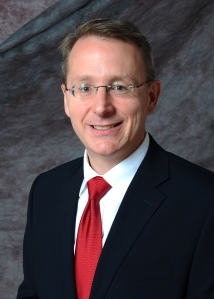Winter 2014 in Louisville has been pretty rough compared to recent years; sub-zero temperatures, several inches of snow, and plenty of snow days and delayed schedule days on campus. While in Canada, we accumulated more snow in 24 hours (the 72nd consecutive day of snowfall in Quebec) than we had in Louisville this winter! Walking track to track on dynamic day usually meant sinking into waist deep snow at least once or twice and the tracks were not marked with cones but were just carved out of the snow that had accumulated over the past 72 days. Travelling from Montreal to Quebec City was interesting as we were the only team to attend that did not own a set of snow tires for their truck. We were clearly “Out of Our Element.”
Category Archives: Mechanical Eng
Louisville Baja heads north!
Endowed Chair Position

As a prominent position of leadership, this Endowed Chair is expected to be an outstanding scholar, who significantly contributes to the University’s national and international research profile
The Department of Mechanical Engineering is pleased to announce that it has begun a search for a new Endowed Chair Professor. The department is seeking an energetic and recognized leader with expertise in manufacturing related areas, including but not limited to novel materials, materials processing, micro- and nano-manufacturing, design, process control and additive manufacturing. As a prominent position of leadership within the Speed School, this endowed chair is expected to be an outstanding scholar who will contribute significantly to the tripartite mission of teaching, research, and service. All the while, s/he will contribute to the University’s national and international reputation.
This endowed search has already begun and will continue throughout next semester. And the hope is that the position will be filled by the start of the fall semester, 2014. For details on the position, please visit http://tinyurl.com/mzfsf7r
Lost in the Woods
Each baja car built at UofL is given a name based upon the personality that car develops during the season. The 2009 car was named the Chariot of Darkness for being the teams first all black paint schemed car. 2010, The Troop, for its black and white Stormtrooper appearance. In 2011 the car was named Leroy based on a World of Warcraft youtube video because like Leroy Jenkins in the video, Leroy has a tendency to do whatever it wants at times. In 2012, car built Junior; a car that is nearly identical to Leroy with only minor changes to fix mistakes made on Leroy.
Early in the season the team decided that the 2013 car was going to be the team’s first girl because of the curves and hips given to the car’s shape with the new carbon fiber body. So that was part one of the process for naming the car. At the first and second competitions, the car had a tendency of getting “lost” on the endurance track. The car would break down and because the team had no way of seeing or communicating with the driver, they would have no idea where the car was until it appeared in the pits being towed by an ATV; thus, it got “lost.” The car was then aptly named Carmen after the computer game character from the 80’s and 90’s Carmen Sandiego.
This recurring theme of getting lost in the woods not only inspired the name for Carmen but, also became an appropriate title to our 2013 season video. And so without further ado, the 2013 University of Louisville Baja team presents Lost in the Woods.
Engineers and Scientists
By: John S. Usher, Associate Dean
My last blog post basically laid out the idea that engineers play a role in the design of just about every man-made object that we see in our daily lives. I often hear people say that engineers “apply science”, that is, take the findings from scientists like biologists, geologists, chemists, physicists, mathematicians, and more, and apply those scientific concepts to solve problems. In some cases that is true. However, I would argue that it much more commonly goes the other way around. Engineers usually design working systems long before the science is ever understood.
Take for example the steam engine, arguably one of the greatest inventions of all time, and the one which dramatically lead to the Industrial Revolution in the United States. In 1712 the first commercially successful steam engine was developed by Thomas Newcomen. The machine operated, but was crude and very little of the input energy was converted to actual work, with as much as 80% wasted as heat. Much later in the century, James Watt, (yes, that “watt” as in a 60-watt light bulb) worked as instrument maker at the University of Glasgow. He was shown a small model of the Newcomen “atmospheric engine”. Watt studied it and in 1765 realized it could be greatly improved by introducing an external condenser. Watt became famous for his steam engine designs as they became the backbone upon which the American mass production was built.
Yet, the actual science underlying the steam engine, namely “thermodynamics” was virtually non-existent in the late 1700’s. Sadi Carnot, the so called Father of Thermodynamics, published Reflections on the Motive Power of Fire in 1824, nearly a half century after Watt’s findings were well known. The first and second laws of thermodynamics were not known until the late 1850s, based on the works of William Rankine, Rudolf Clausius, and William Thomson (Lord Kelvin). Rankine’s thermodynamic textbook, the first of its kind, was not written until 1859, nearly 100 years after steam engines were commonplace.
Now, I will admit, this is but one example of science trailing engineering, but we can see similar results in many other fields such as electro-magnetism, computer science, chemistry, medicine and more. Look no further than the work of Steve Jobs and Bill Gates and their success with building and selling complex computers while the field of computer science was still forming. Again, we see the engineer “tinkerer” in the garage making an invention work, to improve the quality of life for someone, without the benefit of well-formed scientific principles to help guide the design process.
Fortunately, we are now seeing the lines between science and engineering blur significantly, especially on the cutting edges of additive manufacturing, nanotechnology, genetics and bioinformatics, data analytics and cyber enable discovery. Scientists and engineers now work side by side to unlock the mysteries of mother nature and find ways to apply them to our new technological world. I am enthusiastic and excited about the science and engineering professions and the roles they will play in solving some of the world’s most challenging problems, including, disease, poverty, terrorism, energy, sustainability, and more.
Thanks for reading! If you want to learn more about becoming an engineer, check out our website at http://louisville.edu/speed
On September 28th, sixty cars representing twenty-four universities lined up for the start of the fifth installment of Louisville SAE Baja’s Midnight Mayhem! This unofficial SAE Baja endurance race takes place in late September every year as an event to help team recruit and retain new members and also provide a much more laid back competition environment to come out and have fun racing the cars that they’ve all spent countless hours designing and building. Since 2008, the event has grown each year and has now become the premier off season event for teams to attend! The event is held at Podium 1 Motoplex in Charlestown, Indiana where during the day, dynamic events are held to test individual aspects of the cars and then at 8:00 PM the four hour endurance race begins under the lights!
The University of Louisville fielded three cars this year hoping to sweep the podium and place first, second, and third. During the day, the 2013 and 2011 cars were very productive placing 1st and 2nd in the drivetrain event and 2nd and 3rd in the maneuverability event!
Just before 8:00, the cars lined up at the starting line, four rows of fifteen cars, for the land rush style start. The 2011 and 2013 Louisville cars gridded in the front row ready to lead the field onto the circuit. When the green flag waved, the 2013 car quickly jumped to the front and never looked back! After one lap, a ten second gap between first and second had been made. As the race went on the field thinned but, for Louisville the 2011 and 2013 cars were in 1st and 3rd place with McGill University in 2nd. As the race drew to a close, McGill had drivetrain issues bumping the 2011 car up to 2nd place! Once again, the University of Louisville took home the victory an astounding six laps ahead of 2nd place, the 2011 UofL car! Ohio State University took home third place.
For pictures and information on Midnight Mayhem please visit our Midnight Mayhem Facebook Page!
Life Takes Engineering
People often ask me to explain what engineers do. I always say the same thing. “Look around you.” Everything you see was designed, manufactured and delivered through the use of engineering. EVERYTHING! Not just the obvious techie sort of things like the computer on your desk or the cell phone in your hand, but the ho-hum things like the carpet on the floor, the paint on the walls, the lights overhead, and the electricity powering those lights. And I’m not only referring to the engineering required to design the products themselves. There’s even more engineering required to design the processes to make and deliver those items to you. For example, to make carpeting (designed by chemical engineers) you need a huge factory, structurally designed by civil engineers, with equipment laid out by industrial engineers, filled with machines, conveyors, forklifts, computers and controls designed by mechanical, electrical, and computer engineers. And I haven’t even gotten to what it takes to store it, transport it, and install it. All that just to make carpet? Yeah, and that is one product. Now, I ask you to look around the room you are in right now. If you really take the time to look closely, you will see hundreds, maybe thousands, of individual items; each one requiring engineering for its design and production.
Bottom line, we need engineers to produce what life demands. The sad fact is, however, we as a nation, are not producing enough engineers each year. The US produces less than 100,000 engineering BS degrees per year. That number needs to go WAY up if we are to remain competitive. To do this, kids from a very young age have to be exposed to engineering, math, and science and they need to know what engineers do. Speed School prides itself on its outstanding outreach efforts that attract thousands of elementary and high-school kids to participate in engineering camps and activities. To learn more about those programs, visit our website, http://louisville.edu/speed.
We all need to do more to fill the engineering pipeline with talented young people so that they can meet the complex needs of society in the coming decades.
John S. Usher, Associate Dean, Speed School
New Chairman Joins Mechanical Engineering
After serving an impressive twenty years as M.E. Department Chairman at UofL, Prof. Glen Prater stepped down as chairman this past summer. As one can imagine, he made many notable contributions to academic life in the Speed School; most recently he helped ushered the M.E. program through another successful six-year accreditation and he was instrumental in developing the department’s on-site Masters program at the G.E. Appliance Park (to name just two things). Dr. Prater will continue teaching and conducting research in the M.E. Department. Thank you Dr. Prater!
After a national search, the M.E. Department and the Speed School have hired Prof. Kevin Murphy to serve as the new chairman. Prior to joining UofL, Dr. Murphy was a tenured, associate professor at the University of Connecticut, where he had served as the director of graduate studies and then as associate chairman. He earned his B.S. and M.S. in Mechanical Engineering and Applied Mechanics from the University of Michigan and his Ph.D. in Mechanical Engineering from Duke University. His research focuses on nonlinear vibrations, stability, and solid mechanics. But his work also touches on acoustics, signal processing, and fracture mechanics. In particular, he has worked on vibration based structural health monitoring (SHM), adhesion/sticking contact in MEMS devices, and vibrations in manufacturing problems. Dr. Murphy has been awarded a number of competitive federal grants in support of his research program, including a National Science Foundation CAREER Award. He has also received several awards for distinguished teaching, in addition to being recognized by both branches of the Connecticut State Legislature for teaching excellence.
Welcome to the University of Louisville Dr. Murphy.

